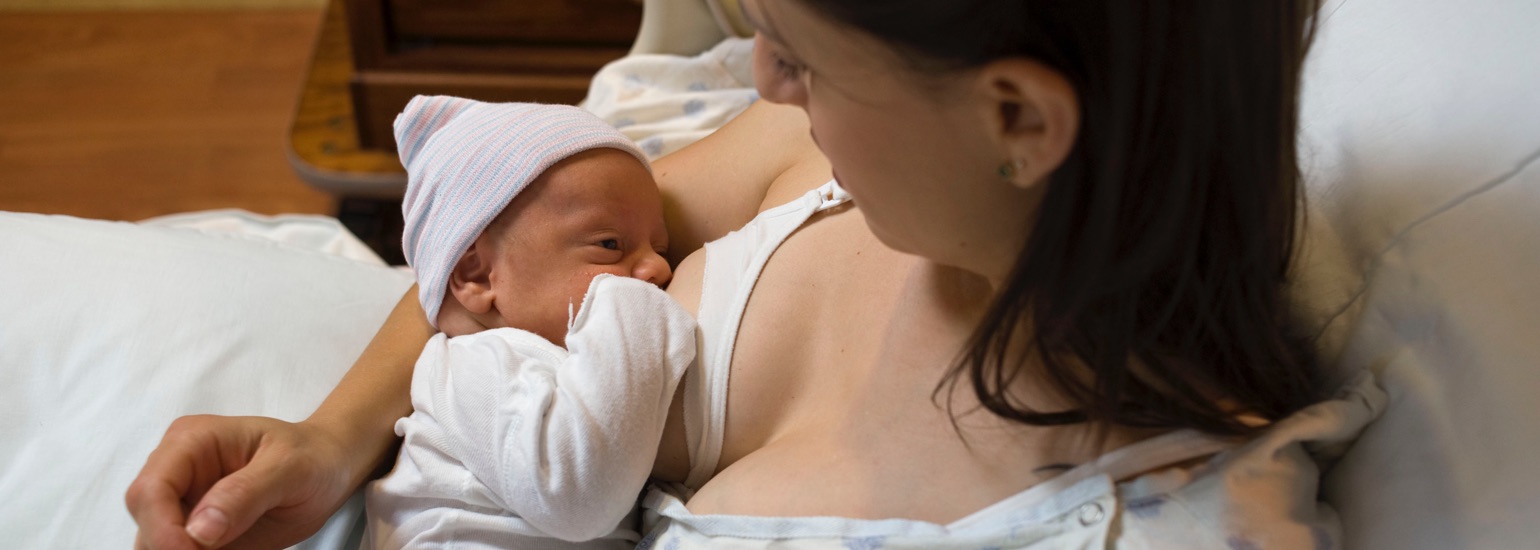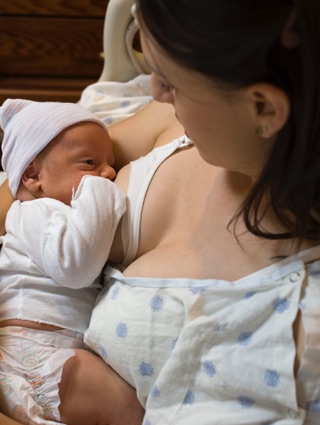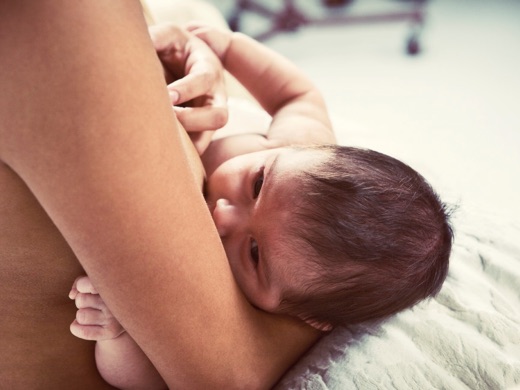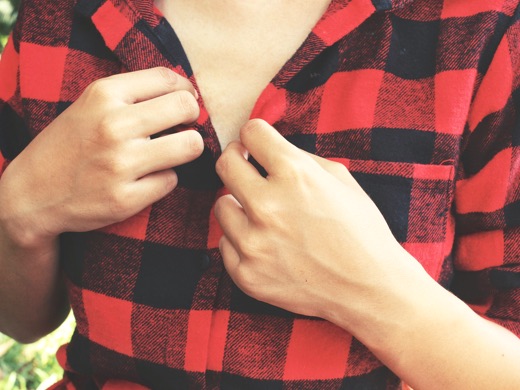Breastfeeding Support 24/7: 855-550-6667
Why are my nipples sore?
You may have tenderness or sore nipples in the first few days as you and your baby are learning to breastfeed. However, sharp pain while breastfeeding usually means that baby is not latched correctly. If you feel any pain, get help from a breastfeeding peer counselor or a lactation consultant as soon as possible to help you feel more comfortable and avoid damage to your nipple tissue.
Prevent sore nipples with correct latch and positioning
1. Make sure you have a good latch.
Most of the time, sore nipples are caused when a baby is not latched on to your breast deeply enough. When baby doesn’t have enough of your breast in her mouth, we call that a “shallow latch.” This shallow latch, in which baby is sucking only on the nipple, will cause nipple pain.
Make sure your baby opens her mouth wide—like a yawn—before bringing her on to your breast and that once she is latched on, she has a good bit of your areola or the darker area around your nipple in her mouth. She should have more of the bottom of the areola than the top in her mouth.
Visit How to Latch for step-by-step illustrations of how to attach your baby deeply to the breast and prevent sore nipples.
2. Make sure baby is positioned correctly
To avoid nipple pain, hold your baby in a good “drinking” position. When you take a drink, your body is in a straight line, and your head is tilted slightly backward. Your baby should look the same. Make sure your baby's ear, shoulder and hip are in a straight line. Her nose should be lined up with your nipple, and her chin should be pressed into the breast.
If you are having trouble with the feeding position you are using, it’s a good idea to try new positions—such as the laid back position. This may help you get a better latch and prevent nipple pain moving forward.
The laid back position
Breastfeeding in the laid back position helps you and your baby relax by getting you both in a more comfortable position. In this position, you are reclining and your baby is lying on top of your chest, belly to belly, with his face on your breast. Not only will gravity keep your baby close to your breast, but the full body contact will also make your baby feel more safe and secure. You may need some pillows around you to help support your breast and your baby. Set yourself up as comfortably as possible before latching. Once baby is latched, if needed, your support person may be able to help you maintain the latch by tucking pillows or rolled receiving blankets under your arms.
3. Try the hamburger hold.
To a newborn baby, latching on to a breast can be like trying to take a bite out of a big hamburger. It can help to shape your breast the same way you might shape a large hamburger to fit into your mouth. This will allow baby to get a lot of breast tissue in her mouth and help prevent sore nipples.
To try the hamburger hold, imagine how you would gently push the top and bottom buns of a large hamburger together to get a nice big bite. This is how you will hold your breast so you can fit more areola into your baby’s mouth. The position of your baby will determine whether you need to hold your breast in the shape of a “u” or a “c.” If your baby is in a cradle or cross cradle position, you will make the hamburger shape by holding your breast in a “u” shape. If your baby is in a football position underneath the breast, you will hold your breast in a “c” shape to create the hamburger. Another way to think about this is if your thumb is directly across from, or parallel to, your baby’s nose, you’re offering your baby a hamburger shaped breast.
If your breasts are full and tender, try hand expressing first to soften your breasts before nursing. This will make it easier for you to shape your breast to try the hamburger hold.
4. Look at your nipple when it comes out of baby’s mouth.
When your baby is finished nursing, your nipple should look slightly elongated and a little bit stretched and rounded at the end. It should not be pinched.
If your nipple looks pinched or angled on the tip, like a new tube of lipstick, that means your baby is not latching properly. Get help from a breastfeeding peer counselor or a lactation consultant right away.
5. Begin feeding on the least painful side.
If one nipple is more tender or sore, start on the less tender side to begin your let down reflex. Once milk flow has begun and your baby has had some milk, she will be less hungry when brought to the second, more tender side. She will nurse less forcefully, making breastfeeding more comfortable.
6. If you feel any sharp nipple pain, re-latch.
Don’t let your baby suckle on just your nipple. In addition to this causing nipple pain, your baby will not get very much milk. You can think of it like your baby is “biting on her straw.” If you try to drink through a straw that you are biting down on, you will not be able to get the full flow of liquid. This is the same situation when your baby is pinching your nipple in a shallow latch, making your nipples feel sore. If it hurts when you begin nursing, gently slide a finger into the corner of your baby’s mouth to break the suction, then start over with a new, deeper latch.
A baby who is latched only to the nipple will not get a full flow of milk, will spend more time at the breast, and will eventually get tired and fall asleep. However, since she did not get her fill of milk, she will likely show hunger cues within an hour or so because she is still hungry. Over time, if your baby is not taking as much milk out of the breast as she needs, this will signal your body to make less milk, and your supply will decrease.
7. Get the timing right: Feed your baby at the first signs of hunger
Try to catch your baby’s early hunger cues, such as turning her head to look for your breast, sucking on fingers and smacking her lips. Waiting too long to breastfeed your baby may cause her to latch aggressively, which will make your nipples feel sore. Waiting longer between feedings can also reduce your milk supply by signaling your body to make less milk.
In addition, when you wait longer between feedings, your breasts become fuller, which can make it harder for your baby to latch deeply and remove milk. Soften your breasts with reverse pressure softening before you try to breastfeed. This will temporarily push milk out of your breasts to soften your breast and areola, allowing baby to get a deeper latch.
Call Your Doctor
If you notice any of the following, call your doctor:
- If you have cracked or damaged nipple skin, or pain that is not improving.
- If you have burning or stabbing pain, or very pink or red nipples.
- If you have bloody nipple discharge.
- If you have other concerns and questions.
Pump or hand express to give your nipples a break
To maintain your milk supply while allowing your nipples time to heal, you can hand express or pump your milk until you are ready to try latching again. Your goal should be to pump eight times a day to mimic how a baby normally eats. Hand express or pump every 2 to 3 hours during the day and every 3 to 4 hours at night. It’s ok to give yourself one longer 5-6 hour stretch of sleep without pumping.
A pumping session consists of double pumping—pumping both breasts at the same time—for 15-20 minutes. If you are hand expressing, spend about 10 minutes manually expressing each breast. Feed baby your expressed milk when she shows early hunger cues and be sure to pace the feeding like you would at the breast by lowering the bottle from time to time to allow her to take breaks. When she stops sucking, falls asleep, turns her head away or pushes out the bottle nipple, she is done.
After the first 4 weeks of life, most babies will take about 3-4 ounces in a bottle feed that replaces a breastfeed, at least eight times every 24 hours. If your baby is in her first few weeks of life, the amount will be less. Check with your pediatrician for volume guidelines and know that using a paced bottle feed will help ensure that your baby takes in what she needs. If you pump more than your baby drinks, be sure to store the extra milk safely. Learn more about storage guidelines.
Once your baby is latching deeper and getting more milk, you can go back to feeding your baby directly at the breast.
Nipple care basics
If you have sore nipples but there are no cracks or open wounds, there is no need to apply ointments. Work on correcting the latch and the nipple pain should resolve within a few days.
- If you do have cracks or other breaks in your skin, you can express a few drops of breastmilk and gently apply it to the nipple area. Allowing the expressed breastmilk to air dry on your nipples may help them feel better. In addition, breastmilk contains germ fighters which may help prevent infection.
- You can also apply a little bit of lanolin or nipple butter to your nipple wounds. These ointments help the skin heal more quickly. Be aware—these “butters” are often oily and can stain your clothing. Place a clean, dry breast pad over the wounded nipples before putting your bra on, or leave your nipples exposed to air if you are able.
Talk to your health care provider about taking over-the-counter pain relief.
What else can cause nipple pain?
1. Your breast pump flange is the wrong size
The breast pump flange is the cone-shaped part of your pump that you hold to your breasts while pumping. If your nipples are rubbing on the sides of the “tunnel” part of the pump flange, your flanges are probably too small. If a lot of your areola is getting pulled into the flange tunnel, your flanges are probably too big. Call your breast pump provider or WIC to help you get different sized flanges.
2. Hormonal changes
Your nipples might feel sore for a few days when you start your period or if you become pregnant again.
3. Cluster feeding
Your baby will ask to nurse more often when going through growth spurts. This can make your nipples temporarily sore, but it will get better as the growth spurt slows down in a few days. Learn more about cluster feeding.
4. Forceful let down
If you are making too much milk or have a fast let down, that can sometimes cause your baby to clamp down on the nipple to control the milk flow. Talk to a lactation consultant or peer counselor to get help with this.
5. Dryness and wetness
Watch out for things that can dry your nipples out, like harsh soaps, or keep them wet all the time, like wet bra pads. These can break down your nipple tissue causing soreness or infection.
6. Skin conditions
Psoriasis, allergic reactions and other skin conditions can also cause soreness. If you think you might be having a rash or allergic reaction, talk to your doctor.
7. Thrush
If you have burning or stabbing pain with very pink or red nipples, this could be a common fungal infection called thrush. Your baby may also have white spots or patches on the inside of his lips and cheeks. Call your doctor or health care provider right away.
8. Other issues
Engorgement, plugged ducts, Raynaud’s phenomenon (blood vessel spasms), tethered oral tissue and a few other less common conditions can also cause sore nipples. If you think you may have any of these, reach out to a lactation consultant or your doctor for help.




